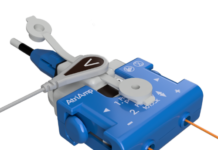Imagine waking up in a hospital, not knowing how you got there or why. And what if you were unable to communicate your confusion to the doctors or nurses around you?
Voxello, which was created in 2013, aims to overcome communication barriers for high-trauma patients with limited mobility. With the “noddle” device, these patients are able to communicate their needs simply with the tap of their finger, blink of an eye, or even the click of their tongue.
These gestures are detected by sensors, which are plugged into a computer. The system sends a signal via Bluetooth to the noddle-chat tablet, which then generates speech on behalf of the patient. The noddle can also be connected to the nurse call system.
Rives Bird, CEO of Voxello, says the company’s device is novel in the market, because it is adaptable to virtually all patients. “Say a patient comes out from the (operating room) — they need a device that is universally adaptable to what that patient can do. We just need to teach them how to use [the noddle].”
Every year, hospitals care for over 3.9 million patients with limited ability to communicate. These patients are three times more likely to experience adverse events because healthcare providers aren’t aware of their needs.
According to a study on Voxello, 52 patients have been enrolled in the United States using the noddle, and none experienced big problems. These preventions could save healthcare facilities about $6.8 billion per year in the United States, according to Perspectives of the ASHA Special Interest Groups in its publication, “The Cost of Not Addressing the Communication Barriers Faced by Hospitalized Patients.”
While the noddle can be used in the long-term care market, it is currently in the early stages of entering the acute care market. As a part of this soft launch, the device has been introduced at UW Health in Madison.
Voxello was founded out of the Iowa Medical Innovation Group program based at the University of Iowa. In IMIG, students work with a professor or medical doctor to model a business based off an idea.
In the past five years, Voxello has achieved a number of milestones: regulatory approvals, FDA clearance in 2017, and electrical and safety clearance. Additionally, partnerships have been secured with five beta distributors.
Yet, Voxello’s growth has not come without challenges. Bird describes how raising capital in the Midwest can be difficult, as it tends to be a “flyover” region. Bird pitched Voxello to investors at the Wisconsin Early Stage Symposium in November.
Bird says he is driven by Voxello’s vision: To overcome communication barriers for patients, especially those in acute care. Reducing the hospital burden for all communication needs with patients is central to the company’s mission.
Their vision includes patients who speak English as a second language.
“There is a law that hospitals must provide translational services for patients not proficient in English at no cost to the patient,” says Bird, yet one-third of hospitals in the United States do not provide this service. The noddle system also has a bilingual application.
As CEO of Voxello, Bird says the most rewarding part of his job is the people he works with. “The team at Voxello is outstanding. Regulatory and engineering almost never get along — except at our company.”
By Caroline Gasao
Gasao is a student in the UW-Madison Department of Life Sciences Communication.




